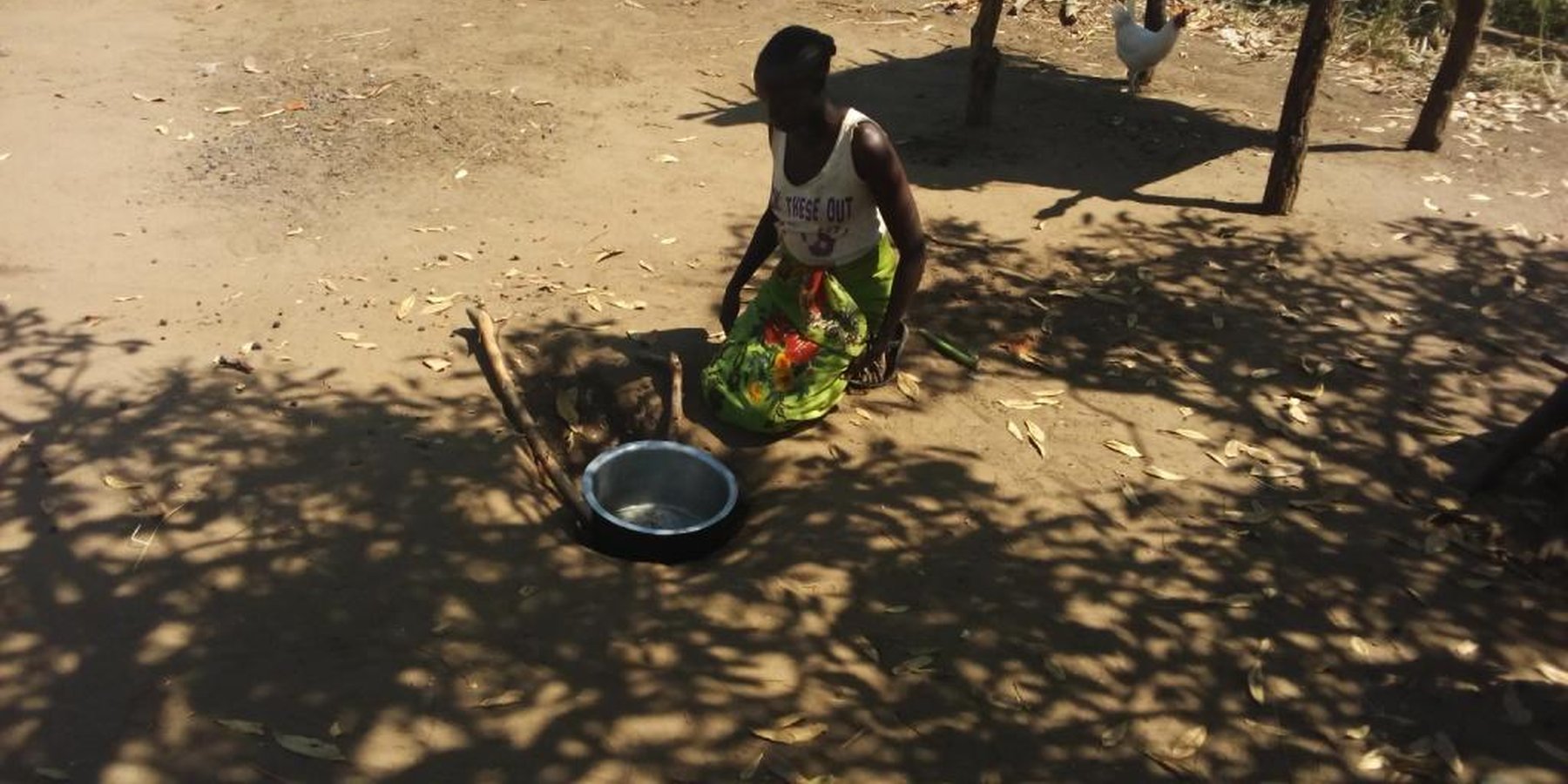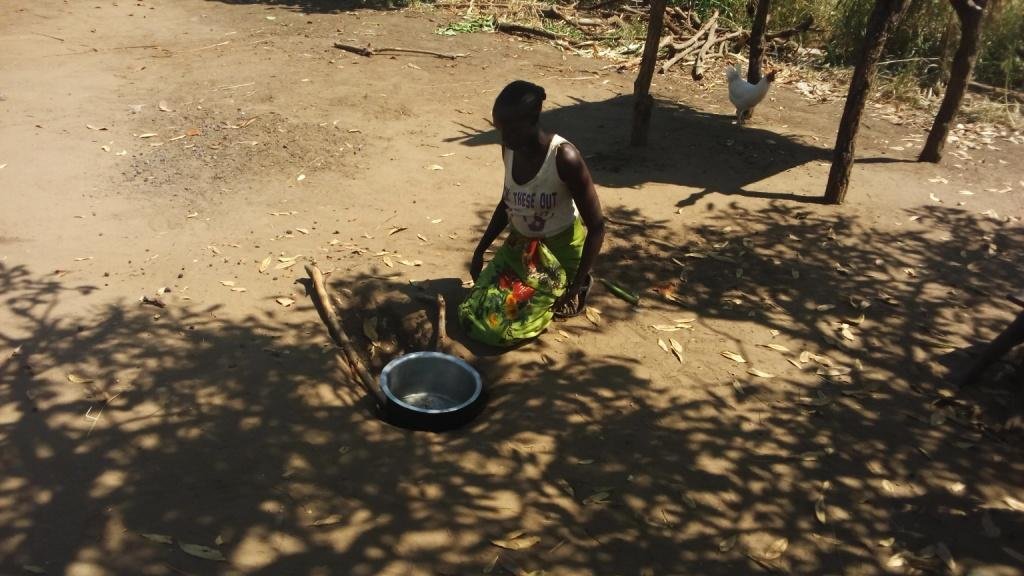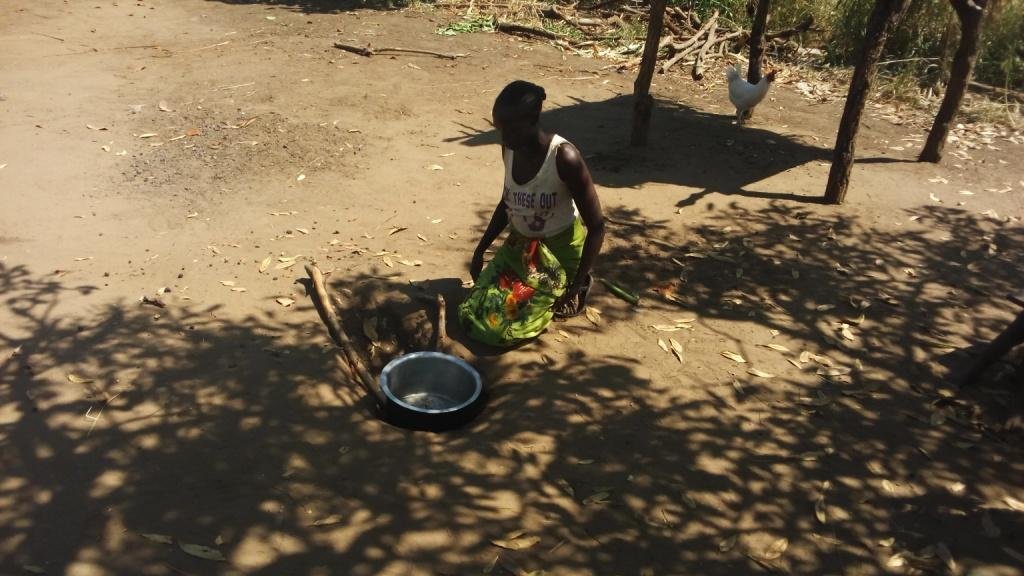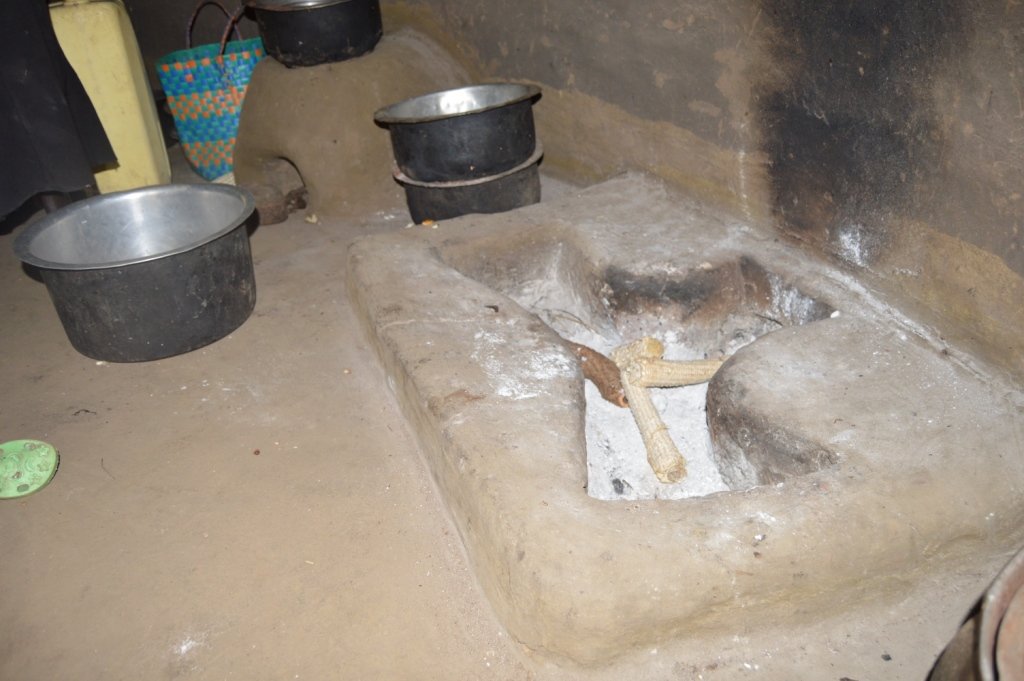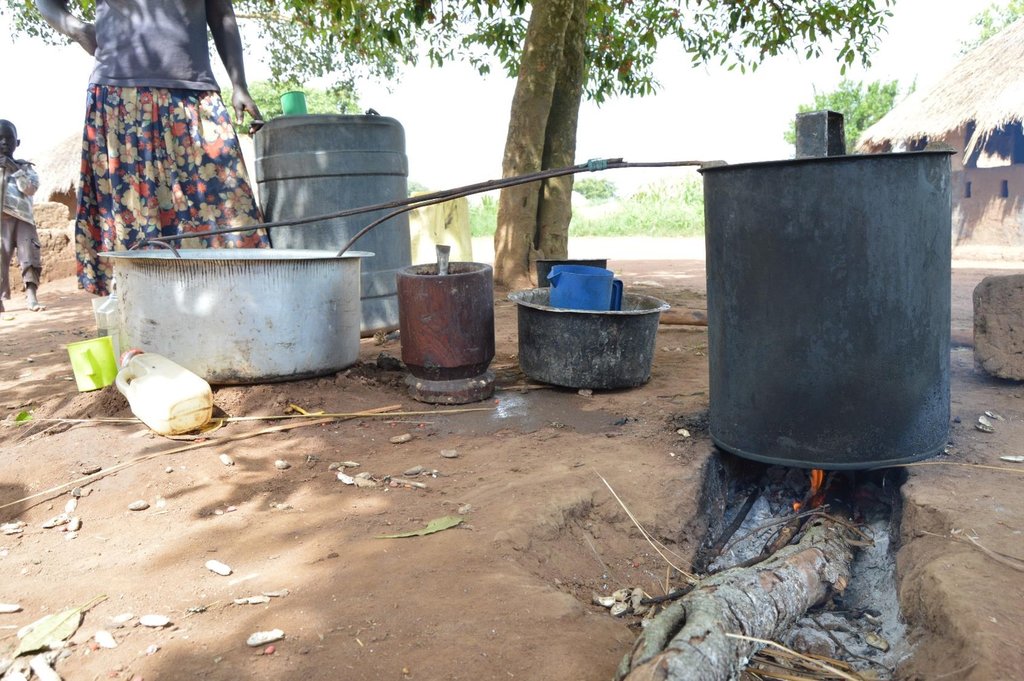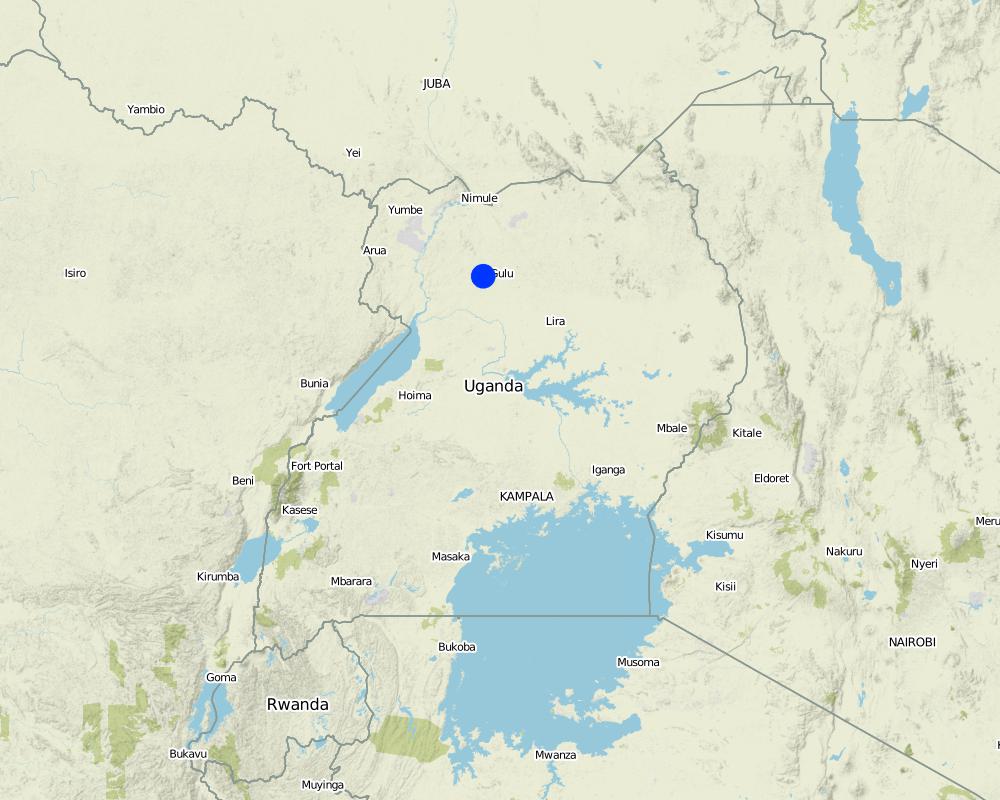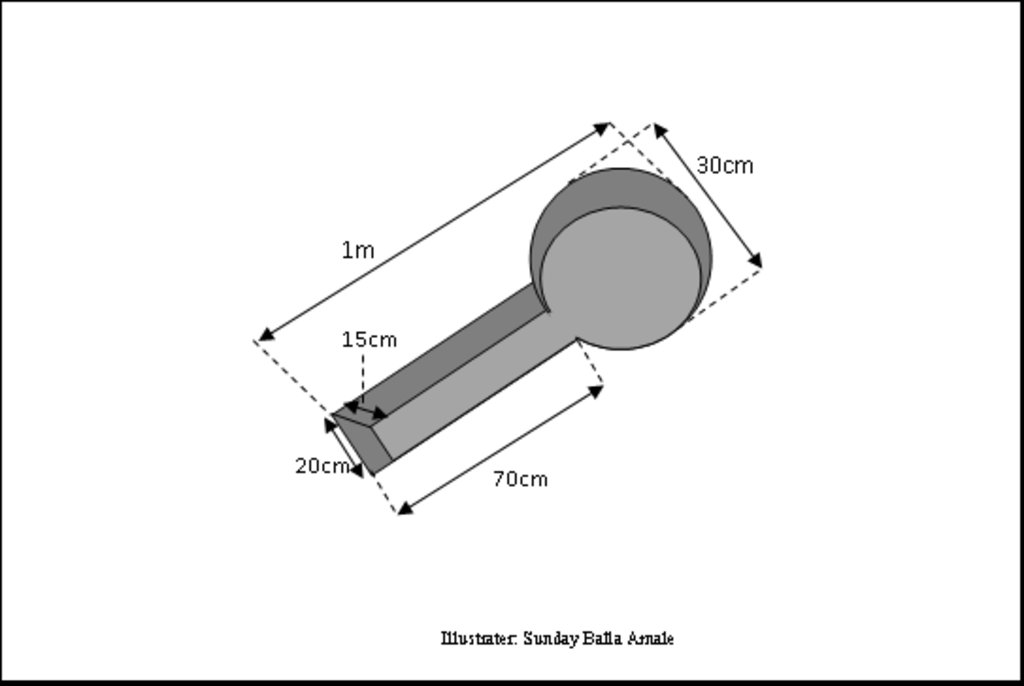Energy-saving ground stoves [乌干达]
- 创建:
- 更新:
- 编制者: Sunday Balla Amale
- 编辑者: JOY TUKAHIRWA, Kamugisha Rick Nelson, betty adoch, Bernard Fungo
- 审查者: John Stephen Tenywa, Nicole Harari, Alexandra Gavilano
keno di-ot (keno di-kal)
technologies_3324 - 乌干达
查看章节
全部展开 全部收起1. 一般信息
1.2 参与该技术评估和文件编制的资源人员和机构的联系方式
关键资源人
土地使用者:
Ayamo Margret
Peasant farmer
Kweke, Langol Village, Panyabono Parish, Alero Sub-county, Nwoya District
乌干达
有助于对技术进行记录/评估的项目名称(如相关)
Scaling-up SLM practices by smallholder farmers (IFAD)有助于对技术进行记录/评估的机构名称(如相关)
Uganda Landcare Network (ULN) - 乌干达1.3 关于使用通过WOCAT记录的数据的条件
(现场)数据是什么时候汇编的?:
12/12/2017
编制者和关键资源人员接受有关使用通过WOCAT记录数据的条件。:
是
1.4 所述技术的可持续性声明
这里所描述的技术在土地退化方面是否存在问题,导致无法被认为是一种可持续的土地管理技术?:
否
注释:
This is a sustainable energy saving technology.
2. SLM技术的说明
2.1 技术简介
技术定义:
Energy-saving stove is a hole dug in the floor of a hut or in the compound. It helps to reduce the quantity of firewood used for cooking by reducing heat loss and ensuring firewood burning for longer time.
2.2 技术的详细说明
说明:
The rate at which forests are disappearing in northern Uganda is so frightening that strategic ameliorative innovations such as reduced wastage of biomass energy need to be envisioned. As such, the technology known as “energy-saving ground stove or energy-efficient ground stove” is being promoted in the region. This technology ensures that (i) smoke is eliminated in the kitchen, thus achieving a healthy environment, (ii) cooking is done faster while the stove retains beat for longer periods, (iii) up to 60% of firewood used with traditional cooking stoves is saved, and (iv) accidents from open fires are prevented.The energy-saving ground stove is constructed by digging a hole inside the kitchen or in the compound. For domestic food preparation, the hole is usually 1 square meter and 15 cm deep. The end where firewood is inserted is about 20 cm wide; while the opposite end where the fire burns is about 30 cm wide. Sometimes, the ground hole is lined with a layer of clay on the floor and walls. During construction, the common wind direction should be noted, especially when the hole is constructed outside the house. Constructing this ground hole does not require much technical skill although making a good one requires some experience. A hand hoe is commonly used for digging the hole, but any ground excavating tool can be used. This technology helps to preserve heat in the soil for further cooking; thus reducing household demand for firewood considerably. Ultimately, this reduces the pressure on deforestation. It also substantially saves women farmers’ precious time, otherwise spent looking for firewood. This technology is particularly important for people who use firewood for cooking, because most energy- saving stoves available in the markets are expensive and require charcoal. Other locally made portable stoves also require charcoal. The challenge with the ground-stove technology is that it is not portable, hence, cannot be moved from one point to another. When constructed outside the kitchen, it becomes filled with water during rainy season, a factor that constrains its sustained use.
2.3 技术照片
2.4 技术视频
日期:
01/07/2018
2.5 已应用该技术的、本评估所涵盖的国家/地区/地点
国家:
乌干达
区域/州/省:
Nwoya
有关地点的进一步说明:
Anaka
Map
×2.6 实施日期
如果不知道确切的年份,请说明大概的日期:
- 10-50年前
2.7 技术介绍
详细说明该技术是如何引入的:
- 作为传统系统的一部分(> 50 年)
3. SLM技术的分类
3.1 该技术的主要目的
- 减少、预防、恢复土地退化
- 保护生态系统
3.2 应用该技术的当前土地利用类型

定居点、基础设施
- 定居点、建筑物
注释:
Applied at cooking points or inside kitchen.
3.3 有关土地利用的更多信息
该技术所应用土地的供水:
- 雨养
每年的生长季节数:
- 2
具体说明:
1st rain between mid march to june, 2nd rain between mid july to november
3.4 该技术所属的SLM组
- 节能技术
3.5 技术传播
具体说明该技术的分布:
- 适用于特定场所/集中在较小区域
注释:
cooking points or kitchen
3.6 包含该技术的可持续土地管理措施

结构措施
- S10:节能措施
3.7 该技术强调的主要土地退化类型

生物性退化
- Bc:植被覆盖的减少

其它
注释:
Deforestation since the pressure on wood cutting is reduced.
3.8 防止、减少或恢复土地退化
具体数量名该技术与土地退化有关的目标:
- 减少土地退化
- 适应土地退化
4. 技术规范、实施活动、投入和成本
4.1 该技术的技术图纸
4.2 技术规范/技术图纸说明
length 1m
burning end : round with diameter 30cm (depends on the purpose and sauce pan commonly used)
firewood input end 20cm (also depends on the purpose)
depth 15cm deep (depends on purpose )
4.3 有关投入和成本计算的一般信息
具体说明成本和投入是如何计算的:
- 每个技术单元
指定单位:
hole
指定体积、长度等(如果相关):
not applicable
其它/国家货币(具体说明):
Uganda shillings
注明美元与当地货币的汇率(如相关):1美元=:
3600.0
注明雇用劳工的每日平均工资成本:
5000 per day
4.4 技术建立活动
| 活动 | 措施类型 | 时间 | |
|---|---|---|---|
| 1. | Identifying a suitable space | 管理 | anytime |
| 2. | Marking lot | 结构性的 | anytime |
| 3. | digging holes | 结构性的 | anytime |
注释:
this cost has never been incurred as a person would simply perform the task himself or herself
4.5 技术建立所需要的费用和投入
| 对投入进行具体说明 | 单位 | 数量 | 单位成本 | 每项投入的总成本 | 土地使用者承担的成本% | |
|---|---|---|---|---|---|---|
| 劳动力 | persons | person hours | 1.0 | 2000.0 | 2000.0 | 100.0 |
| 设备 | hand hoe | piece | 1.0 | 10000.0 | 10000.0 | 100.0 |
| 技术建立所需总成本 | 12000.0 | |||||
注释:
for the cost of hand hoe, the land user maynot meet the cost since it may be available within the farmstead
4.6 维护/经常性活动
| 活动 | 措施类型 | 时间/频率 | |
|---|---|---|---|
| 1. | removing the ash | 其它措施 | once per week |
| 2. | shaping the corners | 结构性的 | once a year |
注释:
There are no recurrent activities except from reshaping the hole after 2-3 years when it will have lost shape.
4.7 维护/经常性活动所需要的费用和投入(每年)
| 对投入进行具体说明 | 单位 | 数量 | 单位成本 | 每项投入的总成本 | 土地使用者承担的成本% | |
|---|---|---|---|---|---|---|
| 劳动力 | personnel | person hours | 1.0 | 2000.0 | 2000.0 | 100.0 |
| 技术维护所需总成本 | 2000.0 | |||||
4.8 影响成本的最重要因素
描述影响成本的最决定性因素:
price of the hoe
5. 自然和人文环境
5.1 气候
年降雨量
- < 250毫米
- 251-500毫米
- 501-750毫米
- 751-1,000毫米
- 1,001-1,500毫米
- 1,501-2,000毫米
- 2,001-3,000毫米
- 3,001-4,000毫米
- > 4,000毫米
有关降雨的规范/注释:
two rainy seasons separated by short dry spell between june and july. dry season between december to march
注明所考虑的参考气象站名称:
Gulu
农业气候带
- 半湿润
5.2 地形
平均坡度:
- 水平(0-2%)
- 缓降(3-5%)
- 平缓(6-10%)
- 滚坡(11-15%)
- 崎岖(16-30%)
- 陡峭(31-60%)
- 非常陡峭(>60%)
地形:
- 高原/平原
- 山脊
- 山坡
- 山地斜坡
- 麓坡
- 谷底
垂直分布带:
- 0-100 m a.s.l.
- 101-500 m a.s.l.
- 501-1,000 m a.s.l.
- 1,001-1,500 m a.s.l.
- 1,501-2,000 m a.s.l.
- 2,001-2,500 m a.s.l.
- 2,501-3,000 m a.s.l.
- 3,001-4,000 m a.s.l.
- > 4,000 m a.s.l.
说明该技术是否专门应用于:
- 不相关
关于地形的注释和进一步规范:
applied in the homestead, compound or inside the house/hut
5.3 土壤
平均土层深度:
- 非常浅(0-20厘米)
- 浅(21-50厘米)
- 中等深度(51-80厘米)
- 深(81-120厘米)
- 非常深(> 120厘米)
土壤质地(表土):
- 中粒(壤土、粉土)
土壤质地(地表以下> 20厘米):
- 细粒/重质(粘土)
表土有机质:
- 中(1-3%)
5.4 水资源可用性和质量
地下水位表:
5-50米
地表水的可用性:
中等
水质(未处理):
不良饮用水(需要处理)
水的盐度有问题吗?:
否
该区域正在发生洪水吗?:
否
5.5 生物多样性
物种多样性:
- 中等
栖息地多样性:
- 中等
5.6 应用该技术的土地使用者的特征
定栖或游牧:
- 定栖的
生产系统的市场定位:
- 生计(自给)
非农收入:
- 低于全部收入的10%
相对财富水平:
- 贫瘠
个人或集体:
- 个人/家庭
机械化水平:
- 手工作业
性别:
- 女人
- 男人
土地使用者的年龄:
- 青年人
- 中年人
5.7 应用该技术的土地使用者拥有或租用的平均土地面积
- < 0.5 公顷
- 0.5-1 公顷
- 1-2 公顷
- 2-5公顷
- 5-15公顷
- 15-50公顷
- 50-100公顷
- 100-500公顷
- 500-1,000公顷
- 1,000-10,000公顷
- > 10,000公顷
这被认为是小规模、中规模还是大规模的(参照当地实际情况)?:
- 小规模的
注释:
technology applied at household level
5.8 土地所有权、土地使用权和水使用权
土地所有权:
- 个人,未命名
- 个人,有命名
土地使用权:
- 个人
用水权:
- 社区(有组织)
注释:
they have spring water for drinking
5.9 进入服务和基础设施的通道
健康:
- 贫瘠
- 适度的
- 好
教育:
- 贫瘠
- 适度的
- 好
技术援助:
- 贫瘠
- 适度的
- 好
就业(例如非农):
- 贫瘠
- 适度的
- 好
市场:
- 贫瘠
- 适度的
- 好
能源:
- 贫瘠
- 适度的
- 好
道路和交通:
- 贫瘠
- 适度的
- 好
饮用水和卫生设施:
- 贫瘠
- 适度的
- 好
金融服务:
- 贫瘠
- 适度的
- 好
6. 影响和结论性说明
6.1 该技术的现场影响
社会经济效应
生产
能源生产
SLM之前的数量:
collect fire wood once a week
SLM之后的数量:
collect firewood after every fortnight
注释/具体说明:
after SLM, little wood is required for their cooking activities
收入和成本
农业收入
注释/具体说明:
increased since time spent in collecting firewood is put in farming
社会文化影响
farm land cultivated
SLM之前的数量:
2
SLM之后的数量:
2.5
注释/具体说明:
more time to work on farm
6.2 该技术的场外影响已经显现
温室气体的影响
注释/具体说明:
efficient energy utilization
有关影响评估的意见:
This technology has indirect impacts on reducing land degradation.
6.4 成本效益分析
技术收益与技术建立成本相比如何(从土地使用者的角度看)?
短期回报:
积极
长期回报:
非常积极
技术收益与技术维护成本/经常性成本相比如何(从土地使用者的角度看)?
短期回报:
积极
长期回报:
非常积极
6.5 技术采用
- 10-50%
在所有采用这项技术的人当中,有多少人是自发地采用该技术,即未获得任何物质奖励/付款?:
- 90-100%
注释:
usually common among people brewing alcohol
6.6 适应
最近是否对该技术进行了修改以适应不断变化的条件?:
否
6.7 该技术的优点/长处/机会
| 土地使用者眼中的长处/优势/机会 |
|---|
| Less time needed for collecting firewood since wood demand is reduced. |
| Reduced cutting down of trees since demand for firewood is reduced. |
| Heat stored in the ground makes food cook very fast. |
| After cooking, the heat in the soil is used to roast sweet potatoes or cassava. |
| 编制者或其他关键资源人员认为的长处/优势/机会 |
|---|
| The technology is cheap and does not require technical skills. |
| It can easily be scaled up to highly populated areas since it takes up a very small space. |
| The technology is cheaper than any portable energy saving stoves available in the market. |
6.8 技术的弱点/缺点/风险及其克服方法
| 土地使用者认为的弱点/缺点/风险 | 如何克服它们? |
|---|---|
| Cannot be moved from one point to another. | |
| If in the compound, rainwater clogs inside it. | Cover it with carpet during rain. |
| 编制者或其他关键资源人员认为的弱点/缺点/风险 | 如何克服它们? |
|---|---|
| Corners need shaping over time. | Use clay to stabilise corners of the ground hole. |
7. 参考和链接
7.1 信息的方法/来源
- 实地考察、实地调查
1
- 与土地使用者的访谈
2 farmers
- 与SLM专业人员/专家的访谈
1
链接和模块
全部展开 全部收起链接
无链接
模块
无模块


